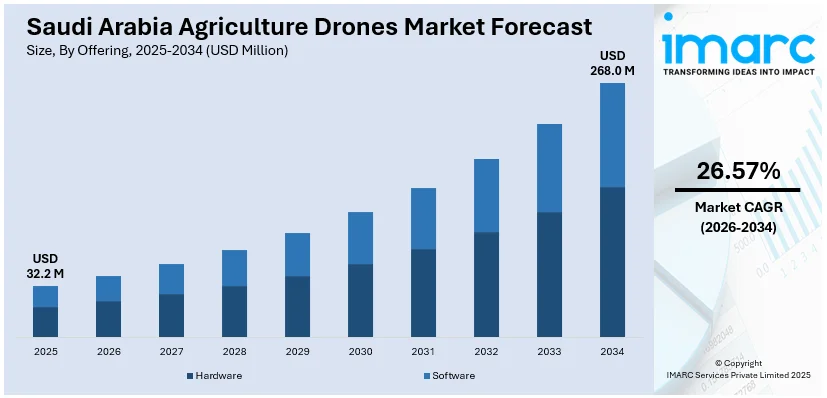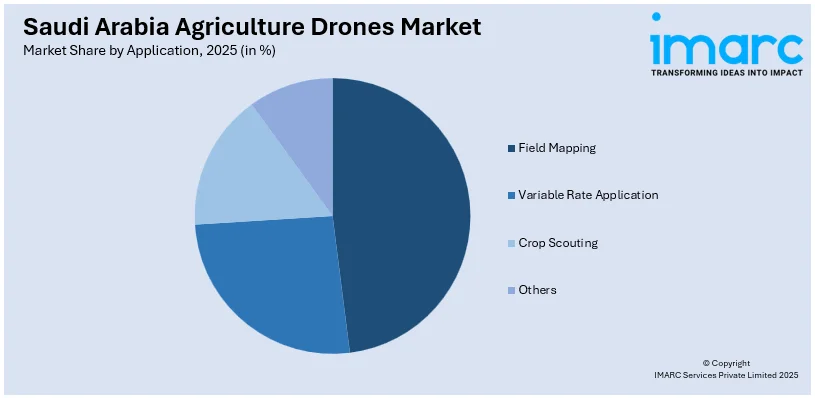
Saudi Arabia Agriculture Drones Market Size, Share, Trends and Forecast by Offering, Component, Farming Environment, Application, and Region, 2026-2034
Saudi Arabia Agriculture Drones Market Overview:
The Saudi Arabia agriculture drones market size reached USD 32.2 Million in 2025. Looking forward, IMARC Group expects the market to reach USD 268.0 Million by 2034, exhibiting a growth rate (CAGR) of 26.57% during 2026-2034. The market is expanding, driven by the heightened efforts to modernize agriculture under the Vision 2030 initiative, declining groundwater levels and rising prices of desalinated water, and increasing demand for crop monitoring and yield optimization technologies.
|
Report Attribute
|
Key Statistics
|
|---|---|
|
Base Year
|
2025 |
|
Forecast Years
|
2026-2034
|
|
Historical Years
|
2020-2025
|
| Market Size in 2025 | USD 32.2 Million |
| Market Forecast in 2034 | USD 268.0 Million |
| Market Growth Rate 2026-2034 | 26.57% |
Saudi Arabia Agriculture Drones Market Trends:
Government Initiatives Supporting Agricultural Innovation and Vision 2030 Goals
The Saudi government's efforts to modernize agriculture under its Vision 2030 initiative are a major driver for the development of the agriculture drones. Through Vision 2030, the nation seeks to diversify its economy away from oil and achieve food security through sustainable agriculture. Drones are viewed as an important tool in this shift, optimizing the use of resources, raising yields, and minimizing environmental footprint. The Ministry of Environment, Water, and Agriculture (MEWA) has initiated various digital agriculture initiatives that encourage the use of precision farming technologies, such as drones. Subsidies, pilot projects, and partnerships with technology providers are also being utilized to make drone technology accessible to local farmers. According to ESG News, in 2024, Saudi Arabia’s MEWA secured SAR 37 Billion via private investments to improve the country’s agriculture and food markets.

To get more information on this market, Request Sample
Water Scarcity and the Need for Precision Agriculture
Saudi Arabia suffers from a long-term water shortage, necessitating effective use of water in agricultural activities. Agriculture drones are a cutting-edge solution for managing irrigation with high accuracy, and they assist farmers in identifying parched spots and optimizing water supply. With multispectral and thermal sensors, agriculture drones allow monitoring of soil water content and plant health in real time, effectively minimizing water waste. In a nation where a major portion of water usage is allotted to agriculture, technologies that optimize irrigation efficiency are in great demand. Precision agriculture through drones not only saves water but also reduces input costs and increases productivity. With declining groundwater levels and desalinated water being expensive, drone-enabled irrigation management is a strategic imperative. The Saudi Arabia sustainable agriculture market is expected to reach USD 0.30 Billion by 2033.
Rising Demand for Crop Monitoring and Yield Optimization Technologies
Saudi Arabia's farming industry is now gravitating towards data-based farming for increased crop productivity and viability. Agriculture drones play a critical role in gathering high-resolution aerial imagery that enables farmers to spot problems like pest infestations, nutrient deficiencies, and diseases before they escalate. These data help make interventions at the right time, limiting losses and boosting overall yield. Given the extreme temperatures and volatile soil conditions prevalent in the area, regular monitoring of crops is necessary to ensure agricultural productivity. Drones help achieve this through frequent and non-destructive monitoring, which is more effective compared to manual inspections. Additionally, combining data from drones with artificial intelligence (AI) and machine learning (ML) software enables predictive analysis, enabling farmers to base their decisions on seeding, fertilizer application, and harvesting. In 2025, Saudi Arabia finished its largest indoor vertical farming project in Riyadh by collaborating with Vertical Farms Company (VFCo), Mowreq Specialized Agriculture, and YesHealth Group. The farm reaches a height of 15 meters, features 19 tiers, and has a growing space of 20,000 square meters, utilizing automation and AI-based monitoring technologies
Saudi Arabia Agriculture Drones Market Segmentation:
IMARC Group provides an analysis of the key trends in each segment of the market, along with forecasts at the country level for 2026-2034. Our report has categorized the market based on offering, component, farming environment, and application.
Offering Insights:
- Hardware
- Fixed Wing
- Rotary Wing
- Hybrid Wing
- Software
- Data Management Software
- Imaging Software
- Data Analytics Software
- Others
A detailed breakup and analysis of the market based on the Offering have also been provided in the report. This includes hardware (fixed wing, rotary wing, and hybrid wing) and software (data management software, imaging software, data analytics software, and others).
Component Insights:
- Controller Systems
- Propulsion Systems
- Cameras
- Batteries
- Navigation Systems
- Others
A detailed breakup and analysis of the market based on the component have also been provided in the report. This includes controller systems, propulsion system, cameras, batteries, navigation systems, and others.
Farming Environment Insights:
- Indoor
- Outdoor
A detailed breakup and analysis of the market based on the farming environment have also been provided in the report. This includes indoor and outdoor.
Application Insights:

Access the Comprehensive Market Breakdown, Request Sample
- Field Mapping
- Variable Rate Application
- Crop Scouting
- Others
A detailed breakup and analysis of the market based on the application have also been provided in the report. This includes field mapping, variable rate application, crop scouting, and others.
Regional Insights:
- Northern And Central Region
- Western Region
- Eastern Region
- Southern Region
The report has also provided a comprehensive analysis of all the major regional markets, which include northern and central region, western region, eastern region, and southern region.
Competitive Landscape:
The market research report has also provided a comprehensive analysis of the competitive landscape. Competitive analysis such as market structure, key player positioning, top winning strategies, competitive dashboard, and company evaluation quadrant has been covered in the report. Also, detailed profiles of all major companies have been provided.
Saudi Arabia Agriculture Drones Market Report Coverage:
| Report Features | Details |
|---|---|
| Base Year of the Analysis | 2025 |
| Historical Period | 2020-2025 |
| Forecast Period | 2026-2034 |
| Units | Million USD |
| Scope of the Report |
Exploration of Historical Trends and Market Outlook, Industry Catalysts and Challenges, Segment-Wise Historical and Future Market Assessment:
|
| Offerings Covered |
|
| Components Covered | Controller Systems, Propulsion Systems, Cameras, Batteries, Navigation Systems, Others. |
| Farming Environments Covered | Indoor, Outdoor |
| Applications Covered | Field Mapping, Variable Rate Application, Crop Scouting, Others |
| Regions Covered | Northern And Central Region, Western Region, Eastern Region, Southern Region |
| Customization Scope | 10% Free Customization |
| Post-Sale Analyst Support | 10-12 Weeks |
| Delivery Format | PDF and Excel through Email (We can also provide the editable version of the report in PPT/Word format on special request) |
Key Questions Answered in This Report:
- How has the Saudi Arabia agriculture drones market performed so far and how will it perform in the coming years?
- What is the breakup of the Saudi Arabia agriculture drones market on the basis of offering?
- What is the breakup of the Saudi Arabia agriculture drones market on the basis of component?
- What is the breakup of the Saudi Arabia agriculture drones market on the basis of farming environment?
- What is the breakup of the Saudi Arabia agriculture drones market on the basis of application?
- What is the breakup of the Saudi Arabia agriculture drones market on the basis of region?
- What are the various stages in the value chain of the Saudi Arabia agriculture drones market?
- What are the key driving factors and challenges in the Saudi Arabia agriculture drones?
- What is the structure of the Saudi Arabia agriculture drones market and who are the key players?
- What is the degree of competition in the Saudi Arabia agriculture drones market?
Key Benefits for Stakeholders:
- IMARC’s industry report offers a comprehensive quantitative analysis of various market segments, historical and current market trends, market forecasts, and dynamics of the Saudi Arabia agriculture drones market from 2020-2034.
- The research report provides the latest information on the market drivers, challenges, and opportunities in the Saudi Arabia agriculture drones market.
- Porter's five forces analysis assist stakeholders in assessing the impact of new entrants, competitive rivalry, supplier power, buyer power, and the threat of substitution. It helps stakeholders to analyze the level of competition within the Saudi Arabia agriculture drones industry and its attractiveness.
- Competitive landscape allows stakeholders to understand their competitive environment and provides an insight into the current positions of key players in the market.
Need more help?
- Speak to our experienced analysts for insights on the current market scenarios.
- Include additional segments and countries to customize the report as per your requirement.
- Gain an unparalleled competitive advantage in your domain by understanding how to utilize the report and positively impacting your operations and revenue.
- For further assistance, please connect with our analysts.
 Request Customization
Request Customization
 Speak to an Analyst
Speak to an Analyst
 Request Brochure
Request Brochure
 Inquire Before Buying
Inquire Before Buying




.webp)




.webp)












